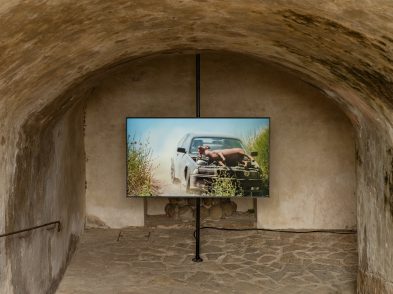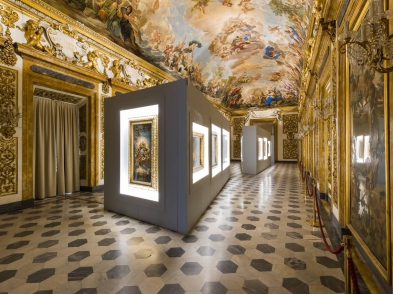For over 50 years, the work of leading Italian artist Giulio Paolini has featured the same materials. Photographs, plaster casts, drawing paper, Plexiglas and a set of objects, including a chessboard, globe and fabric, become participants in a conversation with the biggest themes of existence, time and history. They appear in Paolini’s important exhibition at Museo Novecento. Each one is a container of sorts, not of physical objects but associations with the history of art, ideas and literature. At first, the work appears spare and frugal, eschewing colour and destination, but every element triggers thoughts that open into a potent structure of imagery. The only instrument needed to enter this journey is a pair of eyes and, in Paolini’s words, “absolute devotion to the phenomenon, an ancient one, of seeing”.
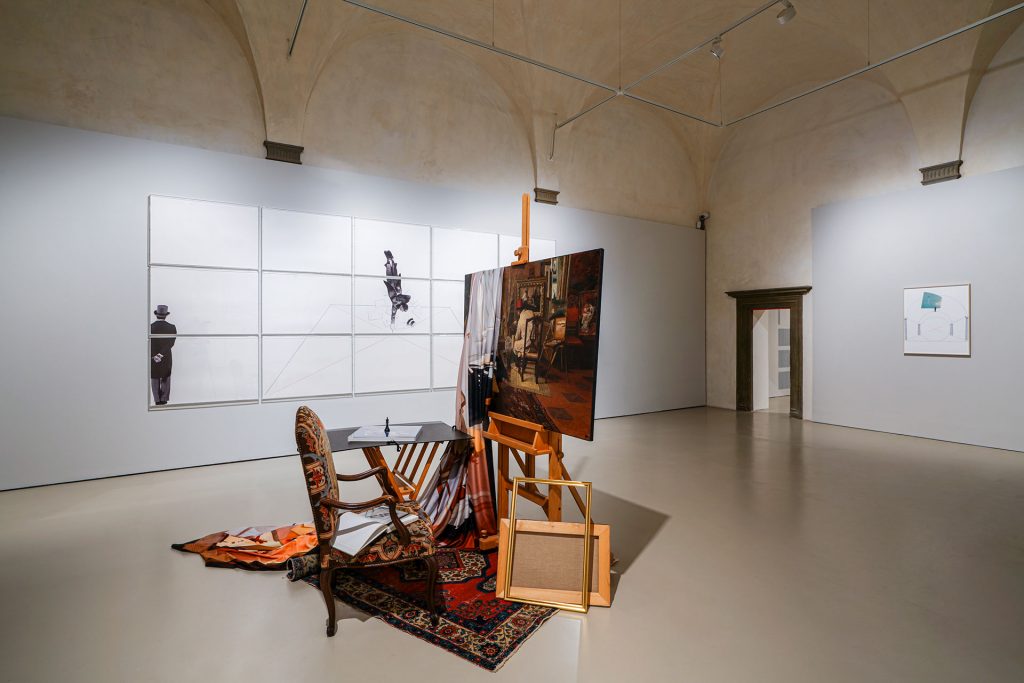
One of the first works on show is a large collage on paper subdivided into 15 panels, with each framed in hard reflective plastic. Three men are depicted, formally dressed in tails and top hats. The disarming title is Caduta Libera (suicida felice) (2018-19), a fate that seems to apply to the central figure, who is nose-diving into a square seen in perspective and crossed by diagonal lines. Is this a metaphor for the secret world of art? The man might represent the artist himself, free-falling into the space reserved for an image that is still vacant. The maker’s search for narrative is beginning, just as it is for the viewer.
Giulio Paolini once said that “to be authentic, a work of art must forget about its author”. Many visitors are used to finding the artist’s life experience expressed in some way in the artwork. Yet Paolini remains strikingly detached from his own production. Instead he accords the artwork an active status alongside the artist and the viewer. The three are connected in an ongoing discussion, like participants in late-night television, trading perspectives and opinions, reaching for a conclusion. When asked to describe the artist’s role, he replied that he is “someone who raises the curtain on a scene which awaits revelation”.
Now 82, Paolini has been acknowledged as a leading figure in the international avant-garde for almost 60 years. One of the pioneers of Arte Povera, the 1960s trend in Italian art towards using non-traditional materials to build a direct relationship between visitors and artworks, he has exhibited in most major galleries across Europe, North America and Japan. An early exponent of what became known as “conceptualism”, he remains immersed in the enigma of creativity rather than in representing reality. Familiar concepts of time or place do not apply: the museum, as a repository of centuries of continuous invention, slips into its own temporal dimension, parallel with the hurly-burly of everyday existence, but separate. Not surprisingly, the title of this exhibition is phrased as a question: Quando è il presente?
“Day after day,” Paolini commented some years ago, “everything is renewed and repeats itself as the natural effect of the incessant becoming of things. In the Museum, by contrast, we can escape from the disquieting destiny marked by the passing of Time. This place seems to be caught in an eternity of its own: here hours, works and people belong to an instant that lives and renews itself through the same enduring illusion: to hold the end of Time in a specific image. ‘Everything flows’ as we know, yet nothing prevents us from turning our gaze elsewhere—without a place or date.”
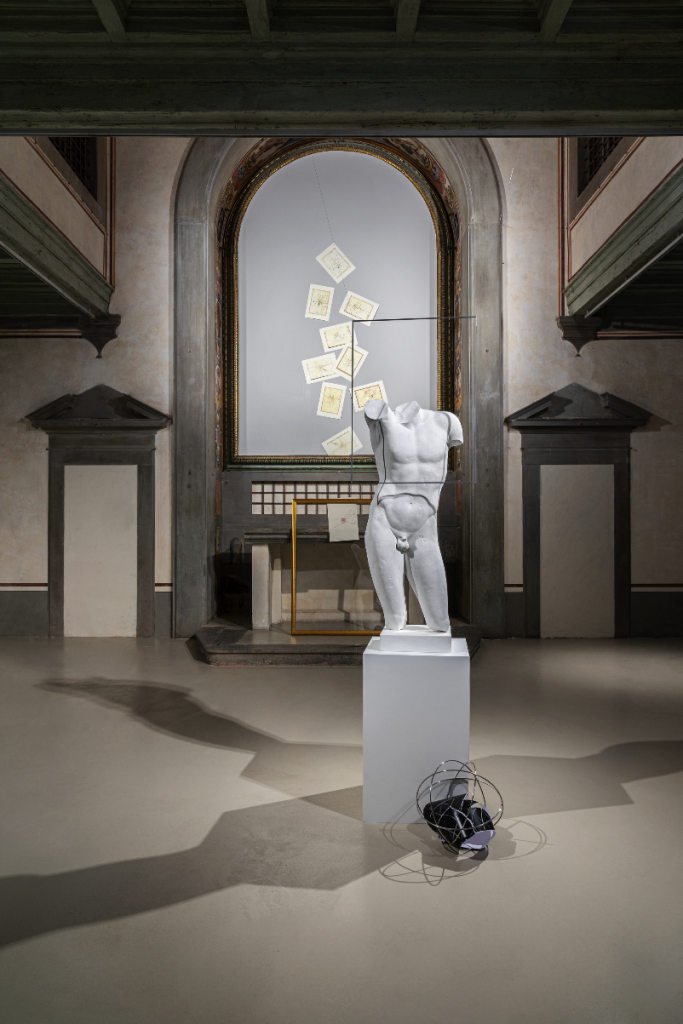
Installed in a former chapel in the museum building, Interno Metafisico (2021-22) alludes to two epochs that many describe as “golden ages”: Antiquity, evoked by a modern plaster cast of a classical figurative sculpture, and the Renaissance, when science and culture advanced new theories about our inner and outer worlds. A globe maybe implies Galileo’s discoveries; it is also a metaphor Paolini enjoys for the “totality” of knowledge that waits to be grasped. In the altar niche, duplicated facsimiles of Leonardo’s scientific drawings fly up the wall once reserved exclusively for religious imagery. The opening opposite that once framed the chapel’s door is now a glazed view outside of Santa Maria Novella and its piazza. Not only do museum visitors look out at people filling the sunny piazza to eat lunch, hurry past or access social media, the elements of this artwork also gaze outwards through the window. At the same time, outsiders peer in, so that two environments seem to interrelate but not touch.
Paolini made his first groundbreaking work in 1960 at the age of 19. He drew intersecting geometrical lines in ink on a gesso-covered canvas to square off the surface as a preliminary for composing a picture in perspective—and he left it at that. The resulting artwork, Disegno geometrico (1960), became his talisman. Freed from containing an image, the white canvas was not empty but waiting, fortified by a linear structure mastered in Florence by the Renaissance architect Filippo Brunelleschi. In a sense, all of Paolini’s work exists at this point, a potent channel that keeps the vast heritage of culture permanently in circulation through re-use, quotation and inspiration.
Art invites its audiences into an illusion. That accounts for the profusion of “duplicates” in the galleries: plaster casts, copies, models and photographs that reproduce rather than originate. The effect is theatrical and Paolini has designed stage sets since 1969. For Maggio Musicale Fiorentino in 1999, he designed sets and costumes for the ballet derived from Pasolini’s film Teorema, with music by Arvo Pärt, Henryk Górecki and others. A recorded performance is screened in this show. The stage is dominated by a gigantic screen that represents the perceived barrier between the outside world and the typical Italian family at the story’s centre. Their guest is gradually revealed as a divine force and his presence shatters the illusion of their bourgeois life. At which point, the bare structure composed of empty frames falls down.
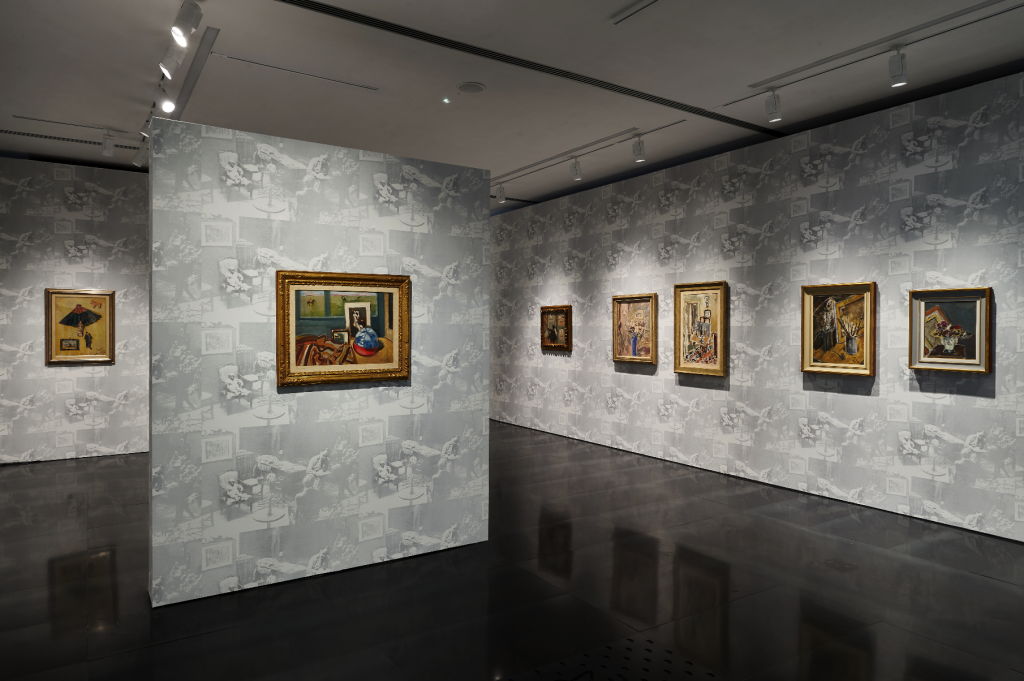
Paolini is encountered in visual and philosophical dialogue with exhibitions by two Italian artists from different generations. The oldest is the Ferrara-born painter Filippo de Pisis, whose most important years occurred either side of WW2, spent in Paris and Italy. When he died in 1956, he was regarded as a modern master because his palette of light colours created astonishingly spare images of wistful, trembling fleetingness. His subjects were often flowers, emblems of transitoriness, but also banal details of home and landscape. With a light, speedy shorthand style, de Pisis registered simultaneously visual impressions and the feelings they stirred in him.
One parallel with Paolini lies in the studio’s importance for both artists; another is their shared reverence for older art. De Pisis recalled the great still-life painter Chardin by exploring the materiality of everyday objects, whereas Paolini’s concept of an artist as a channel for existing images in a timeless flux. That contention helps account for the temporary inclusion of work by Paolini in a cell at San Marco embellished by Fra Angelico.
The third artist on show responds to the sensation that neither older artist leaves space empty in his work; indeed, science confirms that matter, however miniscule, occupies every millimetre. Luca Vitone, born in 1964 in Genoa, Paolini’s hometown, now lives in Milan (Paolini is a long-term resident of Turin) and a recurrent theme in his work is the idea of place, defined by inhabitants now and in the past, architecture and location, and by collective memory. To express the fluid energy he perceives in Paolini’s practice, Vitone has made a painting, as tall as a man, with a uniformly grey surface mottled and inflected by specks and tiny fragments. It is composed entirely of dust collected from Paolini’s studio, from its floor and surfaces, and mixed into a watercolour paint. Vitone captures not a likeness but the essence of his subject, portrayed in traces that circulate like thoughts in motion.
Giulio Paolini: Quando è il presente?
Filippo de Pisis: L’illusione della superficialità
Luca Vitone: D’après (de Pisis-Paolini)
Museo Novecento
Until September 7, 2022

